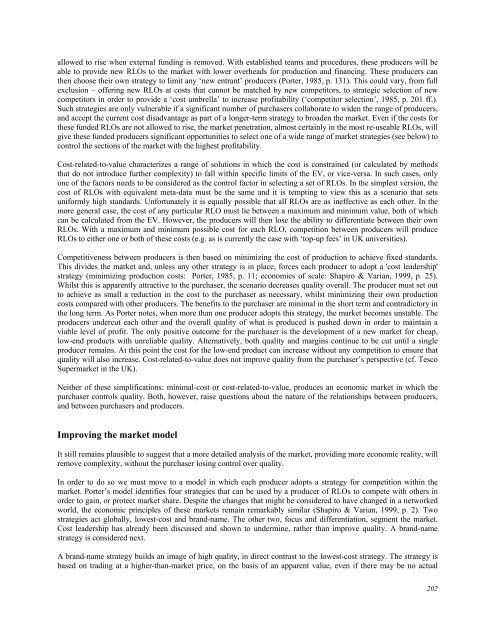October 2007 Volume 10 Number 4 - Educational Technology ...
October 2007 Volume 10 Number 4 - Educational Technology ...
October 2007 Volume 10 Number 4 - Educational Technology ...
You also want an ePaper? Increase the reach of your titles
YUMPU automatically turns print PDFs into web optimized ePapers that Google loves.
allowed to rise when external funding is removed. With established teams and procedures, these producers will be<br />
able to provide new RLOs to the market with lower overheads for production and financing. These producers can<br />
then choose their own strategy to limit any ‘new entrant’ producers (Porter, 1985, p. 131). This could vary, from full<br />
exclusion – offering new RLOs at costs that cannot be matched by new competitors, to strategic selection of new<br />
competitors in order to provide a ‘cost umbrella’ to increase profitability (‘competitor selection’, 1985, p. 201 ff.).<br />
Such strategies are only vulnerable if a significant number of purchasers collaborate to widen the range of producers,<br />
and accept the current cost disadvantage as part of a longer-term strategy to broaden the market. Even if the costs for<br />
these funded RLOs are not allowed to rise, the market penetration, almost certainly in the most re-useable RLOs, will<br />
give these funded producers significant opportunities to select one of a wide range of market strategies (see below) to<br />
control the sections of the market with the highest profitability.<br />
Cost-related-to-value characterizes a range of solutions in which the cost is constrained (or calculated by methods<br />
that do not introduce further complexity) to fall within specific limits of the EV, or vice-versa. In such cases, only<br />
one of the factors needs to be considered as the control factor in selecting a set of RLOs. In the simplest version, the<br />
cost of RLOs with equivalent meta-data must be the same and it is tempting to view this as a scenario that sets<br />
uniformly high standards. Unfortunately it is equally possible that all RLOs are as ineffective as each other. In the<br />
more general case, the cost of any particular RLO must lie between a maximum and minimum value, both of which<br />
can be calculated from the EV. However, the producers will then lose the ability to differentiate between their own<br />
RLOs. With a maximum and minimum possible cost for each RLO, competition between producers will produce<br />
RLOs to either one or both of these costs (e.g. as is currently the case with ‘top-up fees’ in UK universities).<br />
Competitiveness between producers is then based on minimizing the cost of production to achieve fixed standards.<br />
This divides the market and, unless any other strategy is in place, forces each producer to adopt a 'cost leadership'<br />
strategy (minimizing production costs: Porter, 1985, p. 11; economies of scale: Shapiro & Varian, 1999, p. 25).<br />
Whilst this is apparently attractive to the purchaser, the scenario decreases quality overall. The producer must set out<br />
to achieve as small a reduction in the cost to the purchaser as necessary, whilst minimizing their own production<br />
costs compared with other producers. The benefits to the purchaser are minimal in the short term and contradictory in<br />
the long term. As Porter notes, when more than one producer adopts this strategy, the market becomes unstable. The<br />
producers undercut each other and the overall quality of what is produced is pushed down in order to maintain a<br />
viable level of profit. The only positive outcome for the purchaser is the development of a new market for cheap,<br />
low-end products with unreliable quality. Alternatively, both quality and margins continue to be cut until a single<br />
producer remains. At this point the cost for the low-end product can increase without any competition to ensure that<br />
quality will also increase. Cost-related-to-value does not improve quality from the purchaser’s perspective (cf. Tesco<br />
Supermarket in the UK).<br />
Neither of these simplifications: minimal-cost or cost-related-to-value, produces an economic market in which the<br />
purchaser controls quality. Both, however, raise questions about the nature of the relationships between producers,<br />
and between purchasers and producers.<br />
Improving the market model<br />
It still remains plausible to suggest that a more detailed analysis of the market, providing more economic reality, will<br />
remove complexity, without the purchaser losing control over quality.<br />
In order to do so we must move to a model in which each producer adopts a strategy for competition within the<br />
market. Porter’s model identifies four strategies that can be used by a producer of RLOs to compete with others in<br />
order to gain, or protect market share. Despite the changes that might be considered to have changed in a networked<br />
world, the economic principles of these markets remain remarkably similar (Shapiro & Varian, 1999, p. 2). Two<br />
strategies act globally, lowest-cost and brand-name. The other two, focus and differentiation, segment the market.<br />
Cost leadership has already been discussed and shown to undermine, rather than improve quality. A brand-name<br />
strategy is considered next.<br />
A brand-name strategy builds an image of high quality, in direct contrast to the lowest-cost strategy. The strategy is<br />
based on trading at a higher-than-market price, on the basis of an apparent value, even if there may be no actual<br />
202

















